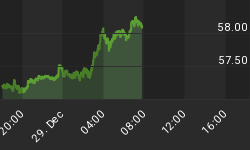The S&P 500 is trading near an all-time record high. But investors should not take this as the all clear signal. According to most indicators, the market is now more overvalued than ever before.
The Cyclically Adjusted Price to Earnings Ratio analyzes the value of the S&P 500 Index with the 10-year average of "real" (inflation-adjusted) earnings as the denominator to determine if the market as a whole is overvalued or undervalued. Today this ratio sits at 26.73, close to the short-term high of 27.2 seen in 2007 and well above its historic average of around 16.
Then we have the Q ratio, developed by James Tobin. This metric takes the total price of the market divided by the replacement cost of all its companies' assets. The average Q ratio is .68, but the latest estimate of the Q ratio .98. This suggests that the S&P 500 is currently dramatically above the mean.
Adding to this, the total market cap of U.S. stocks is now 122.5% of GDP. This is the highest level since mid-2000, which was during the NASDAQ bubble. This measure reached its peak at 142%, before crashing back to the more traditional level of just 70% by 2002.
And last we have the Price to Sales Ratio of the S&P 500. It is a measure of the Index's value compared to its sales. The most recent Price to Sales is estimated at 1.91, in December of 2015 it was 1.81 and in 2007 it was 1.43. This metric shows the market is vastly overvalued compared to firms' revenue.
All these indicators demonstrate that the S&P 500 is sitting in nosebleed territory. However, while the market marches to ten-year highs, the Ten-year Note yield is hitting historic lows. Bonds and stocks historically have an inverse relationship. This is leading investors to question what the bond market knows that equity investors do not and vice versa. But the correct answer to this seeming conundrum is that both stocks and bonds are in a bubble, which is the direct result of unprecedented central bank credit creation.
The condition of record low bond yields should be the result of a record low deficit and debt to GDP ratios, strong economic growth, which would increase the credit quality of the issuers, and historically low central bank balance sheets.
But today, low bond yields are all about central bank manipulation of bond prices. For instance, the last time the 10-year note was anywhere near this neighborhood was when it reached 2.29 percent in April 1954, during the Eisenhower era. As I noted in my book "The Coming Bond Market Collapse", during the 1950's the United States held most of the world's gold and manufacturing base. The National debt was high but was falling precipitously in relation to the economy; meanwhile, household debt was very low. Also, a strong dollar backed by a partial gold standard and robust economy led to a healthy Treasury market. Bond yields were not a result of central banks manipulating currencies in a frenzied search of inflation to perpetuate a growth fallacy.
But the longer Central Banks stay in the game of thwarting market prices the greater the divergence between economic growth, equity markets, and bond yields will become. This game can last a lot longer than most believe. However, reality will eventually take hold and cause a cataclysmic global bond market collapse.
This is because all asset prices are a function of the so-called "risk-free" rate of return on sovereign debt. Record low and even negative, bond yields have forced yield-starved investors far out along the risk curve in search of a positive return. Therefore, the worldwide sovereign bond bubble has infected; Collateralized Loan Obligations, Mortgage Backed Securities, Municipal Bonds, Real Estate Investment Trusts, Junk Bonds, and Equities...just to name a few of the assets warped by this unprecedented phenomenon.
What will be the sign that equity prices will crash back to reality? The answer in one word is inflation. If, or rather when, these maniacal central bankers achieve "success" in forcing inflation upon the masses; whatever is left of the free market will run for the narrow door to exit all of the assets listed above. Thus, exacerbating the global economic meltdown that must follow the faltering of government debt throughout the developed world.
One more warning for equity holders to heed: As we are all aware, the U.S. housing bubble collapsed back in 2008 and caused a global financial crisis. However, unlike what most market pundits will tell you, a fairly localized Real Estate meltdown cannot be worse than having the entire global sovereign debt market collapse. Blindly riding out this bull market without appropriately hedging your investments is extremely dangerous. Indeed, economic savvy and vigilance have never been more important for your financial health.
















